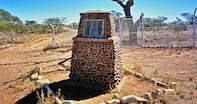Canteen Koppie
In December 1871, Sir Henry Barkly, Governor of the Cape, was appointed Governor of Griqualand West and Canteen Koppie was later renamed Barkly West in his honour. Most of the diggers left when diamonds were discovered on the farms Bultfontein, Vooruitsig and Dorstfontein in early 1871.

Some diggers, however, persevered, and to this day the search for diamonds still continues in this region, both by hand and with modern earth-moving equipment.
Barkly West is not only home to diamond fields - it also houses ancient rock and soil deposits. Comprehending the geological history of South Africa is an almost impossible task; in fact, very few geologists could explain it adequately. Very, very briefly you can say that just about everything in the northern area of the Northern Cape is very, very old (more than 500 million years, or Precambrian).
In the southeast, the Cape Folded Mountains were laid down as shallow marine sands somewhere around 450 and 250 million years ago. In between are the vast Karoo sediments, the creation of which started about 250 million years ago and ended with the great volcanic outpouring about 130 million years later. That's also when the Cape mountains were pushed up, while Gondwana was wrenching itself apart in a tectonic frenzy. Since then it's all been erosion.
At Nooitgedacht, near Barkly West, you can see where the ice dragged itself across 2.5-billion- year-old Ventersdorp rock, originally deposited as lavas. The long, straight grooves are called striations. The 'modern' graffiti is easy to make out. The whorls and other abstract patterns are the work of San, using diamonds from the nearby deposits, naturally.